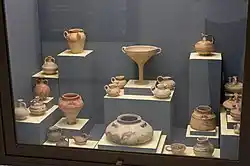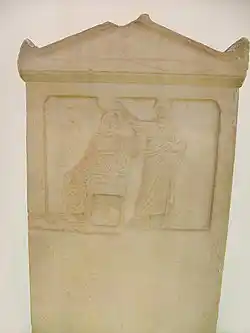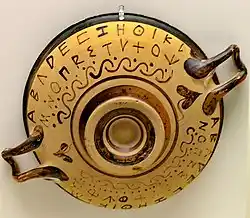
Greek and South Italian ethnicity indicates genetic origins in Cyprus, the Caucasus, southern Russia, and the Mezzogiorno region of southern Italy. Situated at the southern tip of the Balkan Peninsula, surrounded by the Aegean and Ionian Seas, Greece has played a pivotal role in world history. While the spread of Greek culture is associated with the wide-reaching empire of Alexander the Great, inhabitants of the peninsula began a process of colonial expansion into southern Italy as early as the 8th century B.C.E. The extent of Greek presence in southern Italy was such that the Romans later named the area Magna Grecia, “Greater Greece.”[1] The societies of Ancient Greece established settlements across the Mediterranean Basin and the Black Sea. Today, people of Greek and South Italian origin may also be found in Cyprus, the Caucasus, southern Russia, and the Mezzogiorno region of southern Italy.
Research your ancestors on MyHeritage
Greek historyGreek history

The area of modern-day Greece has been inhabited since at least 7,000 B.C.E. The Mycenaean civilization (10th–15th centuries B.C.E.) is considered the first advanced Greek civilization. The Mycenaean collapse ushered in the Greek Dark Ages, a period of significant cultural and demographic decline. However, by the 8th century B.C.E., Greek society experienced a political, cultural, and economic renaissance, including the expansion into Magna Graecia and Asia Minor (modern-day western Turkey). Persian incursion into Greek Ionia in the 5th century B.C.E. precipitated a series of wars between the Persian Achaemenid Empire and the Greek city-states, as well as the subsequent Peloponnesian War fought between Athens and Sparta.
This politically and militarily turbulent period corresponded to the golden age of Greek cultural achievements. Known as the Classical Era (5th–3rd centuries B.C.E.), this period saw a veritable creative explosion in fields such as politics, arts, scientific thought, and philosophy. Politically, the period came to an end with the ascent of Alexander the Great. At its height, Alexander’s empire stretched from North Africa to India, the largest empire of the ancient world. Upon his death in 323 B.C.E., the empire was divided among his generals, launching the Ptolemaic and Seleucid dynasties in Egypt and Mesopotamia. The death of the last Ptolemaic queen of Egypt — the famous Cleopatra — marked the conclusion of the period of Greek cultural dominance known as the Hellenistic Era, and the ascent of the Roman Empire as the leading polity of the Greco-Roman world.
Greece itself came under Roman rule in 146 B.C.E. In 324 C.E., Emperor Constantine adopted Byzantium, an ancient Greek settlement in Asia Minor, as Nova Roma (“New Rome”), and in 330, renamed it Constantinople. For over 1,000 years, the Byzantine Empire — also known as the Eastern Roman Empire, a largely Greek-speaking Christian polity — was the strongest economic, cultural, and military force in Europe, until the conquest of Constantinople by the Ottoman Empire in 1453. Ottoman Sultan Mehmet II instituted the Rum millet (“Roman Nation”), an independent court of law for Eastern Orthodox Christians in the Ottoman Empire.

The 19th century saw the rise of Greek nationalism, and following a successful war of independence fought between 1821 to 1830, Greece was recognized as an independent, sovereign state. After the collapse of the Ottoman Empire, war broke out between Greece and the Turkish National Movement. After 3 years of fighting, a population exchange took place between Greece and newly-founded Turkey, including over 1.5 million Greeks who had remained in Anatolia. During World War II, Greece was occupied by Nazi Germany. Greek resistance was defiant and resolute, and the occupiers responded with atrocious acts of reprisal, leaving tens of thousands dead and almost 1 million Greeks displaced. Despite significant post-war growth, the 1960s saw a period of political turbulence, which culminated in a coup d'état and 7 years of oppressive military rule. Today, Greece is a liberal democracy, a member of NATO and the European Union.
South Italian historySouth Italian history
See also: Italian history
Greeks began to settle in southern Italy between the 8th and 7th centuries BC and the influx of Greek settlers was so significant that the Romans called the region Magna Graecia.[2] Greek control over this region continues until 327 BC, when Romans started to advance south and conquered Neapolis (today Naples), with the Romans taking control of Sicily, the last non-Roman possession, in 241 BC, after the First Punic Wars. In total, the Greeks built 22 poleis (city-states) in Southern Italy and 46 in Sicily.[3] The Byzantine Empire conquered South Italy during the different wars set by Emperor Justinian I, which started in the year 535 and marked the return of Greek influence in the region. This lasted, officially, until 1071, when the Catepanate of Italy was conquered by the Normans. This area comprised between a quarter and a third of southern mainland Italy, and was considered officially to begin south of a line drawn from Monte Gargano to the Gulf of Salerno; however, Amalfi and Naples, located north of that line, also maintained allegiance to Constantinople. After the Norman conquest of southern Italy in the late XI century, this region became the County of Apulia and Calabria and in 1130, part of the Kingdom of Sicily. From 1282 to 1409, the island was ruled by the Spanish Crown of Aragon as an independent kingdom, and was then added permanently to the Crown.[4] The region received a last wave of Greek immigrants after the fall of Constantinople in 1453, when many Greeks fled the areas conquered by the Ottoman Empire, and which became the last wave of Greek influence in Southern Italy. In 1816, the island Kingdom of Sicily merged with the Kingdom of Naples to form the Kingdom of the Two Sicilies, which was handed over by Giuseppe Garibaldi to the House of Savoy and eventually, became part of a unified Italy in 1861.
Greek and South Italian cultureGreek and South Italian culture

Ancient Greece is known as “the cradle of Western culture.” Democracy — literally meaning “rule by people” — has its origins in Athenian political and philosophical thought. Greek contribution to the exact sciences is immeasurable, including the work of masters such as Euclid, Pythagoras, Archimedes, and many others. The escapades of the gods of the Greek pantheon, including Zeus, Apollo, Aphrodite, and others, have provided some of the most enduring themes in Western art and literature. Elements of Greek architecture — as exemplified by the Parthenon, a temple dedicated to Athena on the Acropolis in Athens — can be found in public buildings across the world. Ancient Greece introduced literary forms such as epic and lyric poetry, history, tragedy, and comedy, while the city-state of Athens birthed Western theater. Perhaps the single most important contribution of Greece to the Western intellectual tradition is philosophical thought, which laid the foundations for modern political thought, metaphysics, epistemology, ethics, aesthetics, and much, much more.
Between the 8th–6th centuries BC, Greek settled across the Mediterranean Sea and the Black Sea and set up a large number of colonies; many of these, called apoikia (ἀποικία, "home away from home") eventually evolved into strong autonomous Greek city-states, functioning independently of their metropolis. The areas of settlement in Southern Italy, however, became so Hellenized that Roman writers such as Ovid and Polybius referred to the region as Magna Graecia ("Great Greece"). To this day, some communities in Southern Italy (named Griko) still speak ancient Greek-influenced dialects with substantial Latin borrowings, and worship in the Greek Byzantine Catholic Church instead of the Latin rite more common among Italians. In Modern Greek, Southern Italy is usually referred to as "Lower Italy" (Κάτω Ιταλία) and the Greek dialects spoken there as Katoitalika.
Modern Greek culture is inspired by its illustrious past while incorporating Balkan, Mediterranean, and Western influences. Greek cuisine is famous around the world, with typical dishes including moussaka (an oven-baked casserole of layered eggplant and spiced meat), dolmadakia (stuffed grape leaves), and souvlaki (skewered meat). At the taverna, or Greek café, food and drink (mainly wine or the very popular ouzo, an anise-based alcoholic drink) are often complemented by musical entertainment, commonly featuring the bouzouki, a long-necked stringed instrument. Religion, namely Orthodox Christianity, plays an important role in both Greek private and public culture and provides the backdrop to some of the county’s most beautiful celebrations. During Easter, villages, towns, and cities come to life with candlelit street processions, midnight fireworks, and abundant music, dance, food, and drink.
South Italian culture however, differs from the rest of the country due to the Greek presence in the region for centuries, with the Greeks arriving in Southern Italy in numerous waves of migrations, from the ancient Greek colonization of Southern Italy and Sicily in the 8th century BC through to the migrations from the Byzantine Empire that took place in the 15th after the Ottoman conquest. After that, the links with the Greek motherland were broken and the Greek settlers slowly became Italianized,[5] but retaining significant differences in culture, language and genetic traits inherited from their Greek ancestors. In the Middle Ages, Greek regional communities were reduced to isolated enclaves, and the descendants of those Greeks that resisted the progressive Italianization became known as the Griko people.[6]
Greek and South Italian languagesGreek and South Italian languages

The Greek language is an independent branch of the Indo-European language family, and is spoken by 13.4 million people in areas including modern-day Greece, parts of Cyprus and Albania, and parts of the broader eastern Mediterranean Basin and Black Sea. The Ancient Greek alphabet was imported to southern Italy and adopted by the Etruscans, eventually evolving into the Latin alphabet — the most widely used alphabet in the world today. The Greek alphabet provided the basis for other writing systems, including Cyrillic, Armenian, Coptic, Gothic, and others. The Griko community, comprising around 80,000 people, speaks two different varieties of Italiot Greek, known as Salentino-Calabrian Greek and Apulia-Calabrian Greek, which is a Medieval Greek language influenced by ancient (Doric) Greek, retaining elements that are no longer present in Modern Greek.[7]
See alsoSee also
Explore more about ethnicity estimatesExplore more about ethnicity estimates
- MyHeritage DNA
- Ethnicities around the world at MyHeritage
- What Is My Ethnicity? How MyHeritage Estimates Ethnicities at MyHeritage Knowledge Base
- Where's My Ethnicity?!: Why An Ethnicity Might Not Show Up In Your DNA (and How To Find Evidence Of It Anyway) at MyHeritage Knowledge Base
ReferencesReferences
- ↑ Fanshawe Tozer, Henry. A History of Ancient Geography. Cambridge University Press, 2014. p. 43. ISBN 978-1-108-07875-7.
- ↑ Cerchiai, Luca; Jannelli, Lorena; Longo, Fausto. The Greek Cities of Magna Graecia and Sicily. Getty Publications, 2004. ISBN 978-0-89236-751-1.
- ↑ Hansen, Mogens; Nielsen, Thomas. Inventory of Archaic and Classical Poleis. Oxford University Press, 2004. ISBN 0–19–814099–1
- ↑ N. Zeldes (2003). The Former Jews of This Kingdom: Sicilian Converts After the Expulsion, 1492–1516. BRILL. pp. 5, 69, 296–97. ISBN 90-04-12898-0
- ↑ Jaeger, Werner Wilhelm (1960). Scripta minora, Volume 2. Edizioni di storia e letteratura. p. 361. OCLC 311270347. It began to dwindle in the fourteenth and fifteenth centuries when the South became more and more Italianized and the Greek civilization of Calabria no longer found moral and political support in Constantinople and the Byzantine Empire.
- ↑ Bekerman Zvi; Kopelowitz, Ezra (2008). Cultural education -- cultural sustainability: minority, diaspora, indigenous, and ethno-religious groups in multicultural societies. Routledge. p. 390. ISBN 9780805857245.
- ↑ G. Morosi, Studi sui dialetti greci della terra d'Otranto, Lecce, 1870

